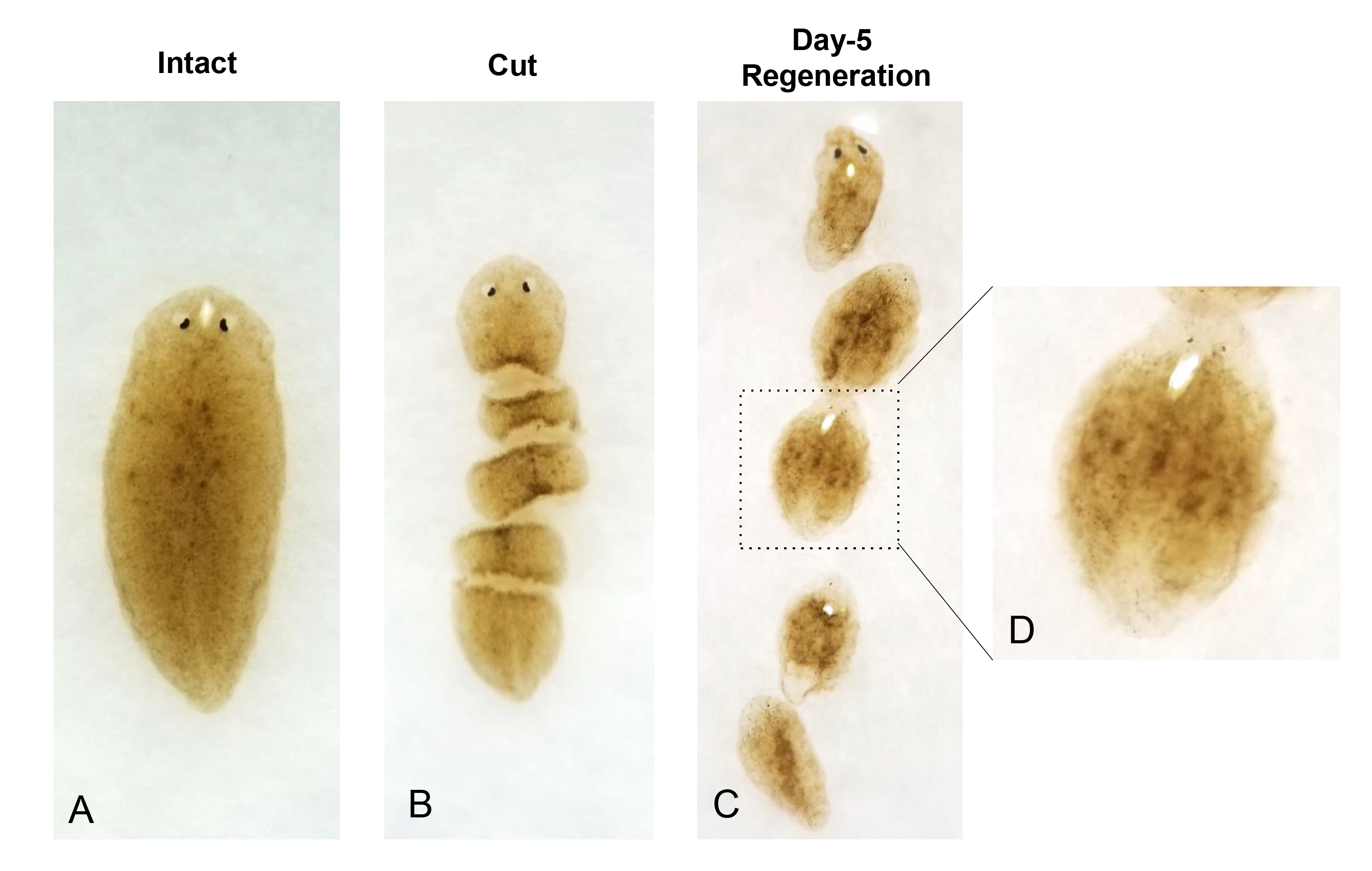26 April 2021
A research team of LKS Faculty of Medicine, The University of Hong Kong (HKUMed) has identified a role of an extracellular matrix protein (ECM), Collagen IV, in the regulation of pluripotent stem cells in the regenerative flatworm (planarian). This collagen plays an important role in regulating how stem cells divide or change in the planarian, crucial to its regenerative capacity and can improve our understanding of human tissue regeneration. This study has been published in Proceedings of the National Academy of Sciences of the United States of America (PNAS) [link to publication].
Planarian and the stem cell niche
The planarian uses its extensive supply of stem cells of high potency, conserved around 30% in adult worm, to regenerate any missing tissue, including even an entire brain after decapitation. How planarians can keep so many stem cells remains a mystery, and has fascinated biologists for over a century.
All stem cells have a home called a ‘niche’ and it is formed by different types of ECM proteins, including collagens. This provides important information to instruct stem cells how to behave, depending on the type of signals present. ECM is fundamental in the building of the surrounding environment of stem cells. Of these, Collagen IV is a very ancient ECM component in the basement membranes between epithelial tissues that has been highly conserved through evolution and is present in all mammals.
This study by researchers of the School of Biomedical Sciences, HKUMed has uncovered a means by which Collagen IV, a key building block of the niche of planarian stem cells, is involved in controlling how these stem cells are used in regenerating missing tissues. The extracellular matrix, in which Collagen IV is one of the components, is fundamental in the building of the surrounding environment of stem cells. This study also presents a major step forward in defining the home of high potency stem cells.
About the study
This study shows that the removal of Collagen IV in planarians will cause the stem cells to divide much faster, but lose their ability to become cells of other tissue types. This will lead to tissue breakdown but not regeneration. This study further linked Collagen IV to a molecular pathway involving a growth factor, nrg-7, produced by neurons. Nrg-7 stimulates stem cell proliferation, and is increased after removal of Collagen IV. However, this causes the stem cells to continue proliferating, and they are unable to turn into other cell types to repair or maintain planarian tissues.
While daily wear and tear or mild damage to tissues and organs can be repaired by resident adult stem cells, repair of or regeneration from major injuries is not possible in human beings. This will require stem cells with higher potency in the right environment to kick-start the process. Since our current understanding of how to regenerate tissues and organs in humans is still limited, deciphering how planarians utilise Collagen IV to keep high potency stem cells in an adult worm, which mammals cannot do, paves the way towards unlocking the mystery and wonders of tissue regeneration in humans.
Professor Danny Chan, Assistant Dean (Research Postgraduate Studies), HKUMed and Professor at the School of Biomedical Sciences, S Y and H Y Cheng Professorship in Stem Cell Biology and Regenerative Medicine, who initiated the study, said, ‘The immortality of an animal under the knife fascinates me as a scientist. What’s more, each cut part can become a new animal blows my mind. The planarian in this study can do just that, a feat enabled by the ability to keep many stem cells as an adult, and to use them in the regenerative process. The planarian can become a new planarian after being cut into several parts, its ability to keep many stem cells and use them in the regenerative process inspired our research. Our finding of an extracellular matrix protein as part of the environment in which planarians can keep stem cells is an important step, with the hope that we can mimic this in humans to rebuild missing tissues. As a bone biologist, I would like to see one day, we can regrow a missing digit.’
The possibility of regenerating missing tissues in human beings is a fascinating dream, and understanding how other organisms such as planarians can achieve such tissue regeneration brings us one step closer in realising this feat in mammalian systems. Future studies that add to our understanding of the ECM in regenerative animals such as the planarian would enable us to use this information in building a suitable ‘niche’ for human stem cells. One such goal would be able to build an artificial stem cell ‘niche’ capable of housing a large number of human stem cells, which can then be applied to damage sites and used to help regenerate tissues.
About the research team
The study was conducted by Professor Danny Chan’s research group, including Dr Andy Chan Shing-fung, former Research Associate, and Dr Sophia Ma Ka-yan, Post-doctoral Fellow at School of Biomedical Sciences, HKUMed. The second corresponding author is Dr Bret J. Pearson from Department of Molecular Genetics, University of Toronto; Program in Developmental and Stem Cell Biology, The Hospital for Sick Children; and Ontario Institute for Cancer Research, Toronto, Canada (three affiliations).
Acknowledgements
This work was supported by the S Y and H Y Cheng Professor endowment in Stem Cell Biology and Regenerative Medicine (to Professor Danny Chan). Dr Bret J. Pearson was supported by Ontario Institute for Cancer Research Grant IA-026.
Media enquiries
Please contact LKS Faculty of Medicine of The University of Hong Kong by email (medmedia@hku.hk).


Follow HKUMed